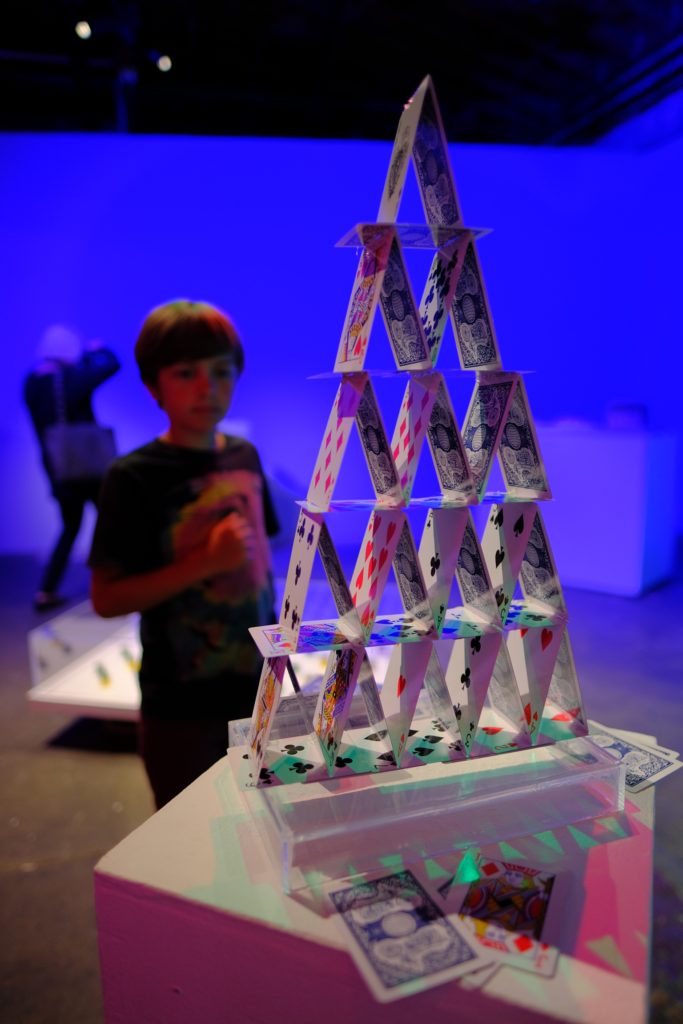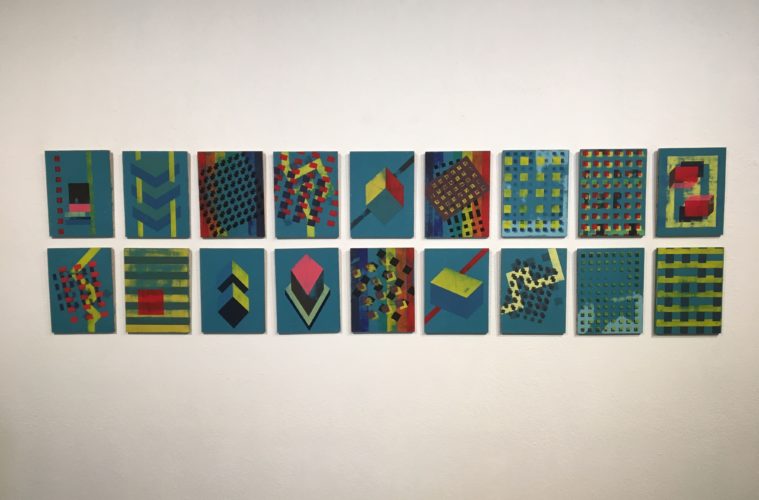Currently on view at the Orange County Center for Contemporary Art, there is a curious assortment of artwork that at first glance resembles building blocks and structural designs. With brightly colored paintings, balancing sculptures and tiny houses, this exhibition is entrancing even at a mere glimpse through the large glass windows of the OCCCA space. The work on view is by two distinctive artists, mixing and mingling their aesthetic styles and their relationships with special structures in the gallery as they tackle the dichotomies of shelter and exposure, identity and community, chaos and order. Every piece of art on view stands out from the next and draws you in with its own story and energy. David Michael Lee and Beverly Jacobs both have an affinity for structure and form, but create wildly different works.

(David Michael Lee)
Catalina Island-based David Michael Lee creates paintings that touch on structure in a variety of ways. His creations often involve simple and brightly colored cubes either floating together in some magnetized relationship on the picture plain, or cube-shaped dwellings that resemble brightly colored Brutalist homes. Within his paintings, a range of technical styles are demonstrated, playing with opacity, layering, patterning and color theory. Although simple in design, Lee’s paintings are hypnotic and otherworldly, forcing us to question our perception of shape, form and color. Recalling a classic video game aesthetic in some works, Lee’s cube structures take on an energy of life to them. The cubes are not just shapes but palpable beings and places, lightly holding their hovering stance in the compositions, like in “Cubes Stacked at Night.”
In other pieces, like Lee’s “Pre-Pleasure Cubes,” beams of light and rainbows penetrate the cubes in various ways, giving the sense that the light and rainbows are physical objects intersecting the dwellings of these compositions. The powerful stripes of color are providing power and weight in these works, forcing viewers to see these simple designs of shapes and color as physical places and spaces, which lends to viewers associating the recognizable imagery in the works as structures they are familiar with, often seeing them as homes.
Interestingly enough, Lee’s home on Catalina Island is stack in a cluster of homes on the hillside of Avalon, while his art studio is in a stacked shipping container on the bay of Avalon. He takes a boat from the island to job at Coastline Community College multiple times in a week. This constant floating and stacking is evident in his life and work. His surroundings and physical reality has infiltrated his inspiration and creative explorations while he comes to terms with ideas of mortality, systems, the human imprint on the environment, and how ideas move across bodies or stay stagnant to be found.
The setting surrounding Lee’s works at OCCCA also lends to viewers seeing the objects in his paintings as homes. Although Irvine-based Beverly Jacobs’ work is quite different from Lee’s, her small houses and building blocks are very clearly homes and human dwellings.
Jacobs’ body of work is ceramic, but her influence seems to range between the human experience, safe spaces, homelessness, the building blocks of shelter, what can be considered a home, and the anthropological aesthetics of community. Because her work is smaller ceramic pieces, she has a much larger number of works on view than her counterpart in this exhibition. Her intimate look at what a home consists of is poetic and reads across all her imagery without any explanation needed. Whether it’s a shopping cart full of bricks telling a story about homes and the weight of homelessness or a ceramic house plastered with the United States Constitution rip into bits with a chimney that has MAGA on it highlighting our terrifying current political climate, Jacobs’ creations touch many different types of people and tell thoroughly poignant narratives and ideas with very little information.

(Joel Jacobs)
Jacobs is an active part of the Irvine community, but also worked as a scientist for a long portion of her life. Her background in physiology, pharmacology and zoology trained her to observe her surroundings and study details about what she saw. She still utilizes these skills in her art practice and helps others utilize those same skills by considering her artwork and their meanings.
Some of Jacob’s works on view were simplified building blocks or bricks, handmade by the artist and smaller than life-size. With the handmade quality and the shift in size, her pieces clearly become simulations and art objects, helping viewers to objectify and analyze their own preconceived notions of these man-made objects. With the fascinating range of housing styles and range of human cultures, the larger style of homes and houses is quite similar across the world. The classic imagery of what a home dwelling can look like has become part of our universal visual vocabulary, and something that Jacobs is very interested in investigating in her work.
In the back of the large gallery space, Jacobs added to the colorful aesthetic of Lee’s compositions with the use of colored lights in a small dim room, with more experimental artworks of homes and houses designed to be slightly humorous. This area, titled the Funhouse according to the sign, included houses of cards, houses that had odd shapes, houses that resembled fairy tales — such as The Three Little Pigs’ houses made of straw, sticks and bricks — and other fun concoctions.
Jacobs uses her artistic outpouring to explore many different aspects of human life and settlement, but she admits that she’s not sure she fully understood why she was interested in making houses and homes when she first began years ago. She does know now, however, that she is fascinated with the idea of how a home can define a person and what groups of houses or homes can say about community and “others.” What is most interesting is that humans, regardless of culture or country are drawn to the imagery and symbolism of a home; it is a comforting imagery that seems to be not just universally understood but also universally desired. Jacobs’ exploration of the imagery also dives into the human psyche in that way, searching for answers to help us better understand our feelings on shelter, exposure, and personal and communal identity.

(Joel Jacobs)
Advertising disclosure: We may receive compensation for some of the links in our stories. Thank you for supporting Irvine Weekly and our advertisers.

